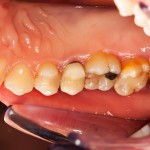
Owing to environmental concerns dental amalgam has been banned in Scandinavia since 2010. In 2013 a treaty of the future of dental amalgam was agreed by the United Nations Environmental Programme’s Intergovernmental Negotiating Committee in Geneva. This will see the phasing down of the use of amalgam. Even before this agreement composite resign materials were gaining in popularity and now represent a significant proportion of directly placed restorations.
Composite resin use is not without concern particularly in relation to its impact on the dental pulp. The aim of this review was to determine whether there are any associations between the incidence of endodontic complications in teeth with vital pulps directly restored with composite resins and those restored with other materials.
Methods
Searches were conducted in PubMed and The Cochrane Controlled Trials Register (CENTRAL) database. Study selection was carried out by three reviewers and study quality independently assessed.
Results
- 10 studies were included (1 Randomised controlled trial, 4 prospective and 5 retrospective studies)
- The quality of the evidence was assessed as low
- 6 studies reported pulpal complications requiring root canal therapy (RoCT) after composite resin or dental amalgam restoration, with 3 studies reporting more complications with composite resins and one study more complications with amalgam. Although the reported differences were negligible.
Conclusions
The authors concluded
Due to lack of scientific evidence, it was not possible to answer the question of whether a tooth with a vital pulp restored with composite resin is at greater risk of pulpal complications than one restored with other materials. The 10 included publications were all judged to be of low quality, and thus, no conclusions could be drawn.
Commentary
With the increasing use of composite resins materials for restorations it is important to know whether there is a greater risk of pulpal complications compared with amalgam. However, as can be seen from this review there is no good evidence to assess the impact. The reviews highlight a number of important methodological issues with main of the studies that they did include, eg. studies providing ‘no clear or specific description of how the condition of the pulp was evaluated prior to restorative treatment,’ and also the lack of a clear description of how pulpal status was assessed. In addition half of the available studies were retrospective which puts them at greater risk of selection bias. Only two databases were searched and it is not clear if the review was restricted to English language studies which could mean that some potentially relevant studies have been missed.
Link
Dawson VS, Amjad S, Fransson H. Endodontic complications in teeth with vital pulps restored with composite resins: a systematic review. Int Endod J. 2014 Aug 5. doi: 10.1111/iej.12364. [Epub ahead of print] PubMed PMID: 25100025.

@TheDentalElf how old were the composite leading to RCT studies?
The oldest included study was published in 1995 the most recent in 2010.
Don’t miss: Composite resin restorations – no good evidence to assess impact on dental pulp http://t.co/G4vHGpU4Jp
I think study has to be wider we need to know the clinician exp, the depth of the cavity how many mm away from pulp, base has been place , liner and base has been placed and the handling of composite during placement this factors play a role to the case study, but i can say amalgam better than composite in the mean of ability to adapt to oral environment by tarnish corrosion …etc but composite will lead to shrinkage and this lead to more food accumulation and the result in secondary caries on other hand corrosion if happen that is mean no gap initially and need longer time for the gap to be occur .